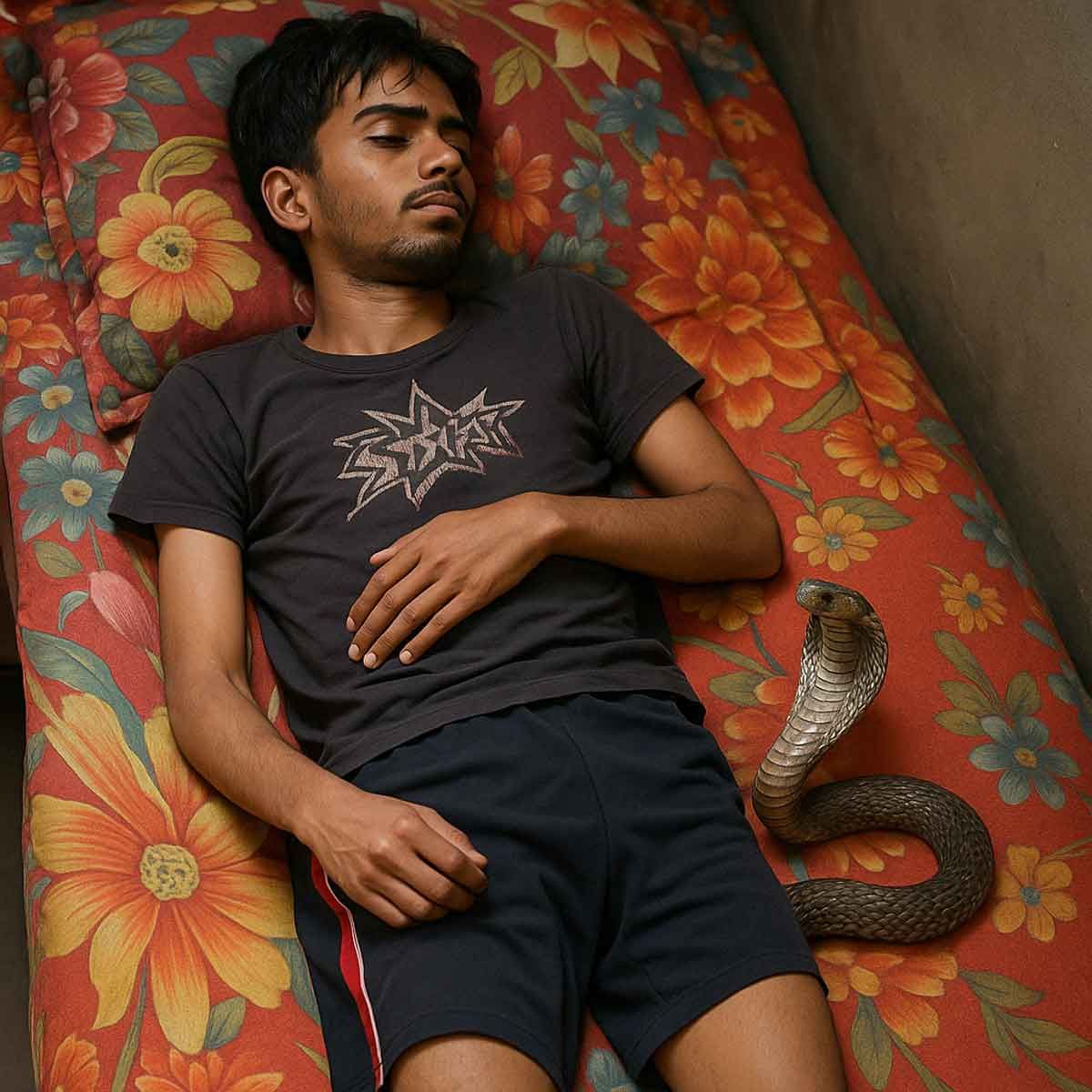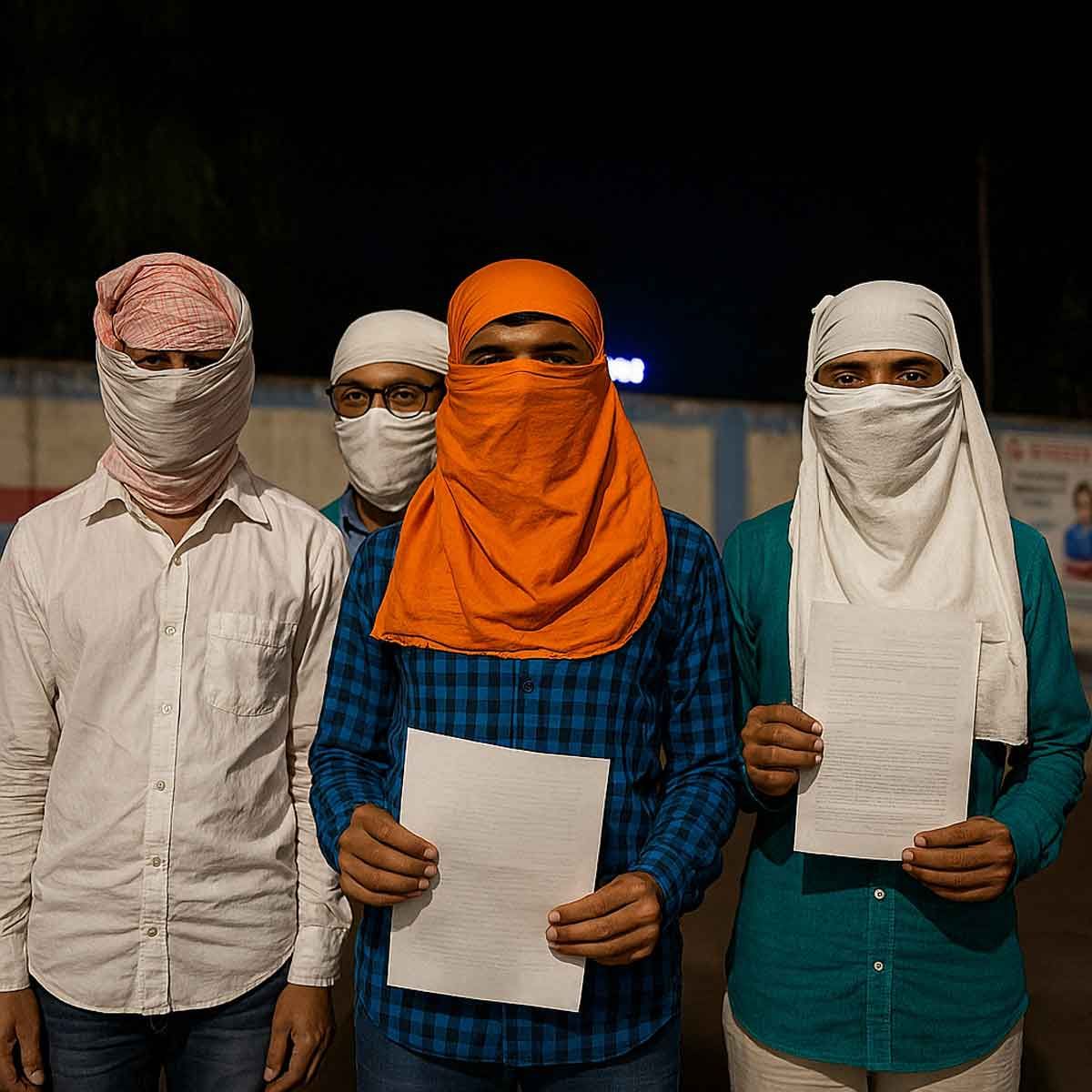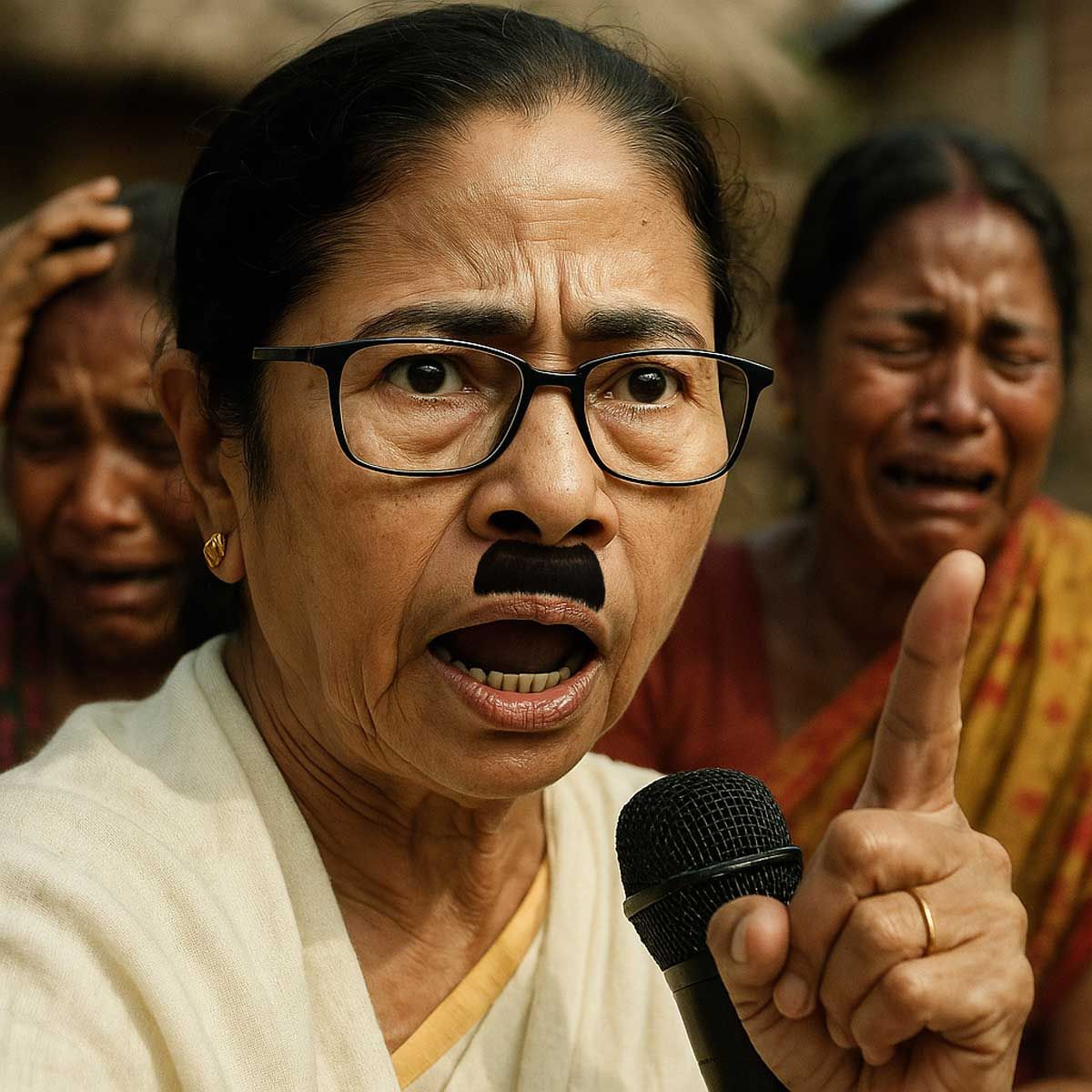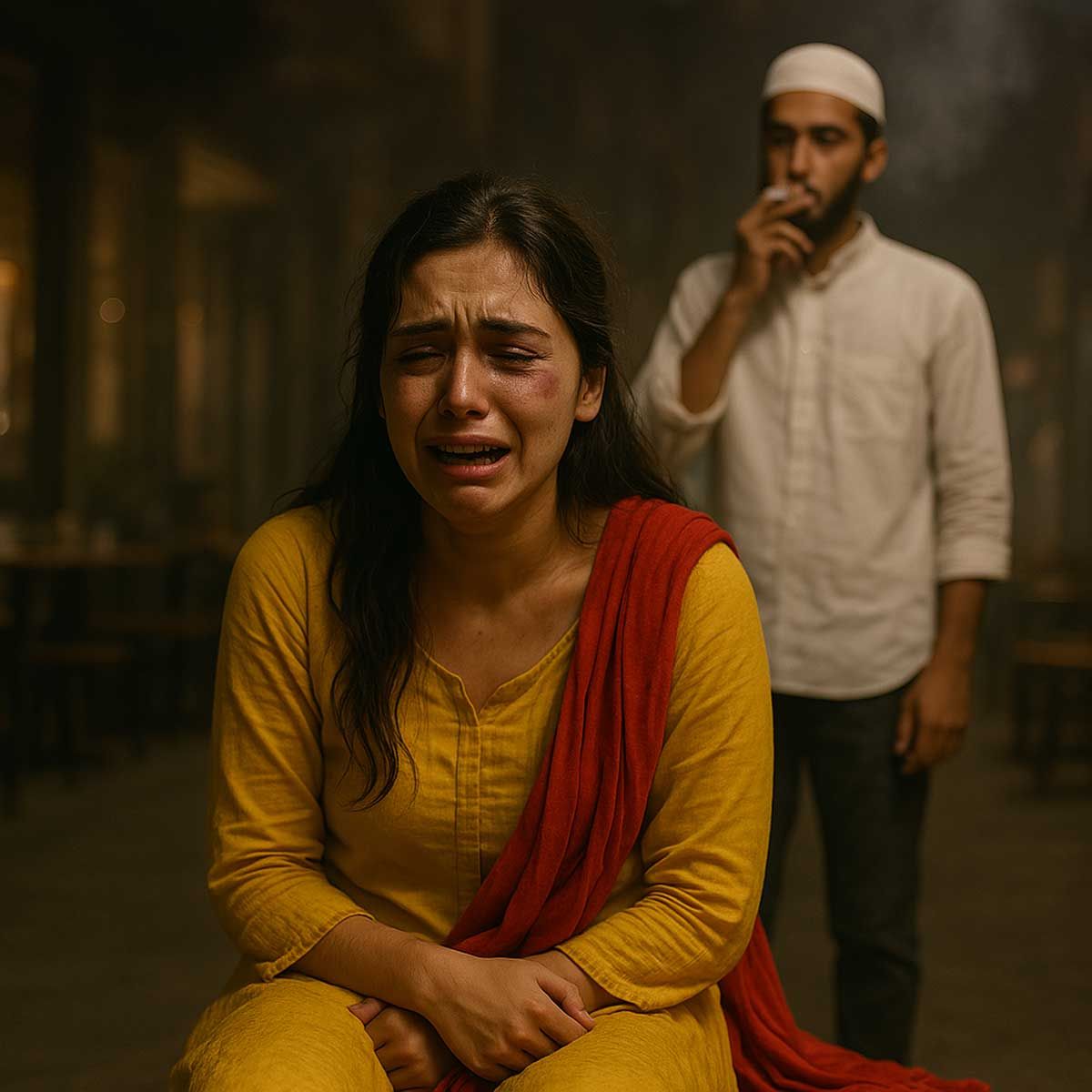More Coverage
Twitter Coverage
Satyaagrah
Written on
Satyaagrah
Written on
Satyaagrah
Written on
Satyaagrah
Written on
Satyaagrah
Written on
JOIN SATYAAGRAH SOCIAL MEDIA
"Division Tactics": National Herald targets Gujaratis & Jains in Mumbai, branding their vegetarianism as 'food terrorism', dive into the intricate web of the paper's legacy and the controversial history of Congress leadership, an unmasked chronicle awaits
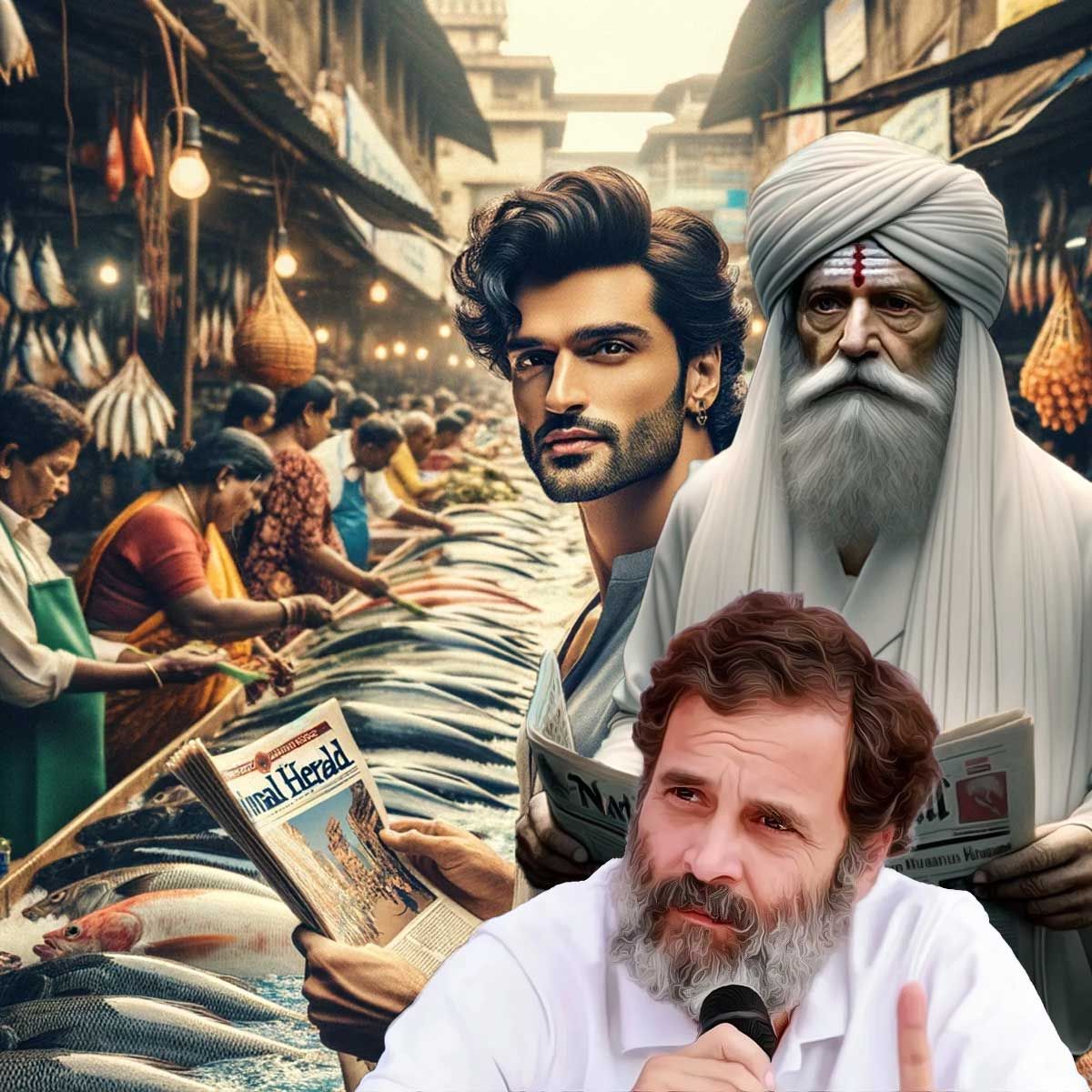
In what can only be described as a pitiable attempt at journalism, the Congress-affiliated National Herald seems to be embarking on a new low. On Tuesday, 24th October, the spotlight was on Sujata Anandan, the editor of this esteemed publication, who seemingly believes in casting aspersions on entire communities, in this case, the Gujaratis and Jains residing in Mumbai.
|
Under the audacious headline of 'Dietary apartheid: Mumbai gets a taste of food terrorism', Ms. Anandan graciously painted the vegetarian practices of Jains and Gujaratis with a broad brush of "food terrorism". One might wonder if she was trying to introduce a new culinary genre or just blatantly misusing journalistic platforms to peddle her divisive rhetoric.
If that wasn't enough to stir the pot, her social media post on platform X read, “Go back to Gujarat if you don’t like the smell of fish and rice – Maharashtrians begin to reclaim their own state.” The implications? Clear and deliberate. By pitting the staple diet of Maharashtrians against the preferences of Gujaratis, Anandan seems to be hinting at an unsaid territorial war over... cuisine?
For a publication already under the scanner for fraud allegations, one would assume a more measured approach. Instead, the National Herald, under Ms. Anandan's expert guidance, chooses the path of sensationalism, almost making one wonder if they're in the business of news or creating spurious controversies.
The audacity to label a community's dietary choice as "terrorism" is not just an overreach but also showcases the paper's detachment from ground realities. Such divisive narratives have no place in modern India, where unity in diversity has always been celebrated.
In conclusion, while one might argue the freedom of expression and journalistic integrity, there's a fine line between constructive criticism and unabashed mudslinging. For the National Herald and its associates, it might be time to introspect where they truly stand in the spectrum of responsible journalism.
Following on from her initial sensationalistic stance, Sujata Anandan, in her article for the Congress-run National Herald, further elaborates on her coined term "food terrorism". One can't help but raise an eyebrow at the deliberate choice of such a term. A term which, in its essence, evokes extreme connotations in an age where true acts of terrorism have caused immeasurable grief to countless innocent souls.
Ms. Anandan, not to be outdone by her initial claims, dives deeper into this alleged divide by narrating various incidents that supposedly spotlight the Gujaratis and Jains of Mumbai in a distinctly unfavourable light. According to her narrative, these communities have apparently been persecuting Maharashtrians over the simple matter of dietary habits. And if this wasn't alarming enough, she recounts an episode in a Mumbai suburb where, under the banner of this so-called "food terrorism", Gujaratis allegedly resorted to dumping garbage at the doors of Maharashtrian residents. Dog poop, cow dung, you name it. An entire community, in her telling, rallied behind this act, ultimately leading to the ostracisation of the harassed family.
|
Drawing from the annals of history, Anandan cites an incident from the late 1980s involving former Prime Minister Morarji Desai. Apparently, his insistence on the closure of a non-vegetarian restaurant on the ground floor of his building due to disturbing odours is the nascent root of this purported "food terrorism".
But while Ms. Anandan seems determined to paint this narrative of a community-led vendetta over food, the discerning reader might ponder the broader implications of such claims. Is it plausible that an entire community would be collectively villainized over isolated incidents? Or is this just another chapter in the saga of the National Herald's penchant for stirring the pot, banking on the allure of controversy over the integrity of balanced reportage?
In her latest article, Sujata Anandan seems to be championing the rights of Marathis in Mumbai. However, a closer look reveals a deeper narrative that attempts to segment Hindus based on caste and regional identities. Her words resonate with this intention: “Social media posts by young Maharashtrians have been raging against the Shethjis and Bhatjis – Gujarati traders and priests – and calling to banish them from Mumbai and Maharashtra! Former Maharashtra minister Jitendra Awhad of the Nationalist Congress Party pointed out that the Kolis (fishermen), the Agris (who built Mumbai for the British) and the upper-crust Pathare Prabhus (who gave the city a cultural mooring) are the original inhabitants of Mumbai.”
For context, this isn't the first time Anandan has stirred the pot. Her historical posts on X (previously known as Twitter) have sparked controversies. One such instance is when she attributed the valor of Chhatrapati Shivaji Maharaj to the Mughals. In another post, she claimed that Shivaji's armed forces indulged in looting and violence against civilians. Such statements led to a legal complaint by BJP leader Nitesh Rane, culminating in a case at the Santa Cruz police station.
Now, Anandan's narrative seems to be evolving. She frames Jains, Gujaratis, and other upper-caste Hindus practicing vegetarianism as proponents of "food terrorism". By doing so, she not only appears to advocate for the non-vegetarian Marathi community but also seems intent on deepening the divide between various communities in Mumbai. This choice of words and narrative comes from the editor of the National Herald, a publication which, it's worth noting, has been accused of fraudulent activities and has ties to the Congress party.
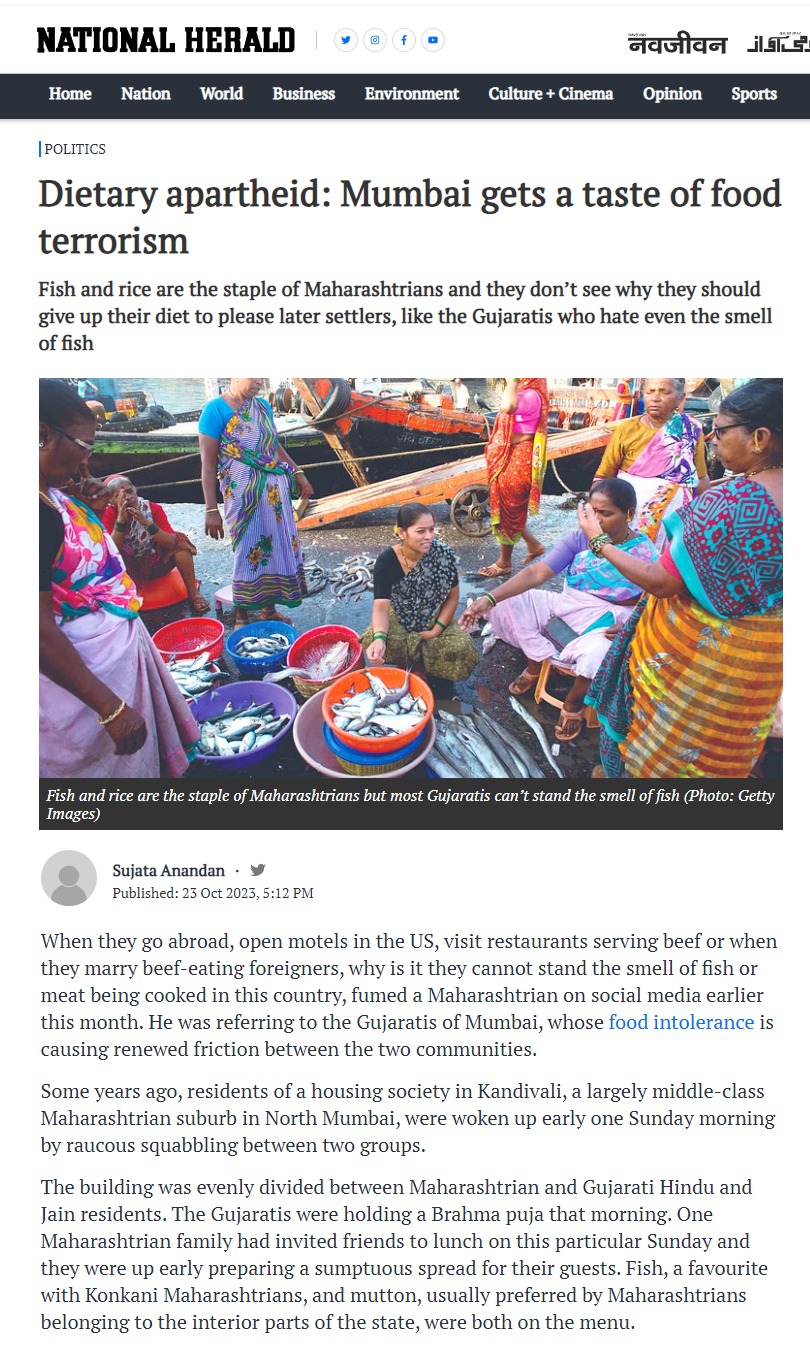 |
National Herald and the Dubious Antics of Congress Leadership
In a nation working diligently to recover from the after-effects of a devastating global pandemic, political unrest has added fuel to the fire. When India hoped for a period of solace after retracting the Farm Laws – following extensive civil unrest and chaos – opposition leader Rahul Gandhi rekindled tensions. During an interview in London, he painted a grim picture, describing India as a powder keg, awaiting a spark to set it aflame.
However, an important perspective arises – the threat from external forces is amplified when internal rifts are deep. The prevailing political climate seems to corroborate this, as politicians appear willing to go to great lengths, perhaps making it convenient for external entities aiming to destabilize India.
From the protests against Nupur Sharma to the outcry against the Agnipath scheme – which seeks to benefit non-graduate students – there seems to be no end to the strife. But a pattern emerges. In the aftermath of violent outbursts over allegations of blasphemy, purportedly sparked by Islamist groups on a particular Friday, the supporters of Rahul Gandhi took to the streets in seemingly coordinated demonstrations. As soon as the furor over perceived "Gustaakh-e-Rasool" (Insult to the Prophet) subsided, the streets were taken over by "Gustaakh-e-Rahul" (Insult to Rahul) zealots, further escalating tensions.
|
Amidst a backdrop of political turmoil, the Congress leadership sometime back heightened tensions in the national capital. The trigger? Rahul Gandhi being summoned by the Enforcement Directorate. Interestingly, amidst this uproar, Sonia Gandhi was diagnosed with Covid and was promptly hospitalized. What stood out was the absence of genuine, spontaneous street protests, even as Congress Chief Ministers from two states and other state-level cadres were ushered in for organized demonstrations.
It seemed evident that this entire spectacle was orchestrated by the central figures of the Congress party, and few seemed reticent about this. The overarching narrative suggested that questioning Rahul Gandhi, despite not being the Chief of Congress, was tantamount to sacrilege. The implication being that due to his revered ancestry, even if there are suspicions of corruption, the nation shouldn't dare to question but rather passively accept with unending gratitude towards the Gandhi lineage. This narrative reached comical heights when posters emerged suggesting Rahul Gandhi's lineage traces back to Mahatma Gandhi. The historical mix-up regarding the surname of Mr. Feroze Ghandy has never been leveraged so absurdly in recent memory.
This brings to mind the words of Dr. Ambedkar, who once warned of such unyielding allegiance. In his iconic 'Grammar of Anarchy' speech on the 25th of November, 1949, in the Constituent Assembly, he cited the Irish Leader Daniel O’Connell, stating - "No woman can be grateful at the cost of her chastity and no nation can be grateful at the cost of its liberty." This sentiment feels all too relevant in the context of recent events.
The powerful sentiment expressed by Dr. Ambedkar highlights the dangers of blind allegiance to any political dynasty, especially when it uses its legacy as a shield against rightful investigation. With regard to the Congress leadership, there is a long trail of controversies that have been associated with its key figures over the years.
|
For instance, there's no need to delve into distant events like the Jeep scam and Revolver scams during Nehru's tenure (although Jairam Ramesh, a staunch Congress supporter, does touch upon these issues in his book ‘A Chequered Brilliance’). The focus here is on the contemporary Congress leaders.
While Sonia Gandhi has been portrayed by party loyalists and some sections of the media as a paragon of virtue immune to typical human flaws, it's essential to remember that public narratives often rely on the presumption of a collective amnesia. It's worth recalling instances like when Manmohan Singh was depicted as completely apolitical, conveniently overlooking details like his association with the Rajiv Gandhi Foundation. Such intricate financial dealings and ventures seem to have been a recurring theme for the premier family of Congress over time.
Emergencies often lead to circumstances where the truth is either shrouded in fear or consumed by greed. The Maruti scam stands as a testament to this axiom. Strikingly, this scandal went largely unreported during the Emergency era. The reason? Initially, it was the dread of reprisal that silenced many, and later, the allure of benefits stifled the voices that could have raised alarms.
|
Renowned journalist Vinod Mehta shed light on this issue in his detailed work, 'The Sanjay Story: From Anand Bhavan to Amethi'. The narrative indicates that by 1974, it was evident to the nation and especially to Sanjay Gandhi, that the dream of India's most affordable car was on the brink of collapse. As reality began to overshadow his vision, Sanjay shifted his focus from car manufacturing to the lucrative selling of cement and steel, materials initially procured for the plant's setup, in the open market. This action stood in stark contrast to the stringent License-raj protocols of the era which disallowed the open-market sale of such commodities. As layers of the scam began to peel off, a myriad of faux companies, erected solely for profiteering, were exposed.
However, the plot thickens. It wasn't an act of desperation following the Maruti debacle. The foundational framework for financial diversion was laid even before the inception of Maruti as a car manufacturer. An entity named Maruti Technical Services (MTS) was formulated preceding the launch of Maruti, the car company, with the primary objective of funds' misallocation. This company was primarily controlled by the Gandhi family, holding a staggering 99% of shares. Notably, the stakeholders weren't limited to Sanjay Gandhi alone; Sonia Gandhi, Rahul Gandhi, and Priyanka Gandhi were all in the fold, partnering in this venture. An individual named Shroff played a crucial role in this operation, acting as the linchpin, much akin to Motilal Vora's capacity in the deal.
Sanjay Gandhi's investment in MTS was a mere 1.25 Lakhs, whereas his contribution to Maruti was just 100 rupees at its inception. In a significant twist, Sonia Gandhi was conferred with the position of Managing Director of MTS, drawing a monthly salary, a percentage in net profit, and other supplementary perks. Furthermore, a two-decade-long agreement was established between MTS and Maruti. Under this pact, MTS would offer consultation services to Maruti, charging 2% of the net annual sales value. To kickstart this collaboration, an upfront amount of five lakhs was dispatched to MTS, purportedly for 'supplying expertise in design, manufacture, and car assembly'.
|
The speed of financial recovery for Sanjay Gandhi post this venture was nothing short of astonishing. In just a few months, he recouped his entire investment. A year into this operation, and this ostensibly vacuous entity, consisting of only four members, witnessed an impressive 150% appreciation on their original capital.
By 1975, the intricacies of the financial world unveiled themselves in ways that few could comprehend. MTS, by then, had managed to accumulate a sum of around 10 Lakhs - a significant amount, especially when contextualized with the era. Yet, what befuddled many was the inception of another entity, Maruti Heavy Vehicles (P) Ltd. (MHV). Positioned as a wholly-owned subsidiary of MTS, Sanjay, Sonia, Rahul, and Priyanka collectively held a lion's share of 59% stake in MHV.
The ties between MTS and MHV seemed even more intertwined when MHV agreed to remunerate MTS with 2% of its earnings for consultancy services. Such a business agreement permitted MHV to boast a production value of goods amounting to Rs 16 Lakhs. However, this number was contrasted starkly by the minuscule investment in machinery which stood at a mere Rs 12,331, as pointed out in Vinod Mehta's, 'The Sanjay Story.'
Rajiv Gandhi, on record, had noted that Sanjay might have gotten the papers endorsed by Sonia. However, amidst the swirling controversies, the undeniable fact remained - the coffers were brimming. Vinod Mehta, with resolute confidence, indicated the involvement of the contemporary Gandhi family in this intricate financial maze.
Such convolutions in business structures, where entities seem to thrive without clear production or sales, isn't an anomaly in the annals of history.
|
Segueing to another narrative, the story of AJL, Young India, and National Herald is not freshly minted. Going back to the corridors of 1938 in London, the National Herald newspaper took birth under the aegis of Nehru. Disputing the widespread belief, the Associated Journal Limited, the initial powerhouse behind National Herald, was not exclusively Nehru's brainchild. Ownership was a mosaic, spread across the hands of 5000 freedom fighters. The steering wheel of this venture was entrusted to Feroze Gandhi, Nehru's son-in-law, marking a phase of his post-independence rehabilitation.
The illustrious National Herald did not always bask in golden sunlight. As time passed, the editorial team grew increasingly discontented under Feroze's leadership, leading to his eventual resignation. By the time he stepped away, the renowned newspaper was steeped in financial turmoil. Fast forward to 2008, and the paper was shackled with a debt amassing Rs 90 Crores. But the saga didn't end there. Two years later, the Gandhi family conceptualized Young India Ltd., a not-for-profit entity. Swiftly, this new entity claimed ownership of National Herald, absorbing all its assets.
The business maneuvers that followed echoed the convoluted financial intricacies of the past, and arguably, they seemed murkier than the Maruti-MTS fable. Wearing the mantle of a media organization, National Herald managed to secure land allotments. These very lands were subsequently mortgaged to secure loans from banks, with the capital raised - a staggering Rs 120 Crores - channelized to erect a 9-story architectural marvel in Bandra (East), Mumbai.
Navigating through this intricate web, two things emerged unequivocally. First, the path treaded was anything but linear. Second, the main players showcased a penchant for crafting histories that were far from pristine.
This deep-rooted mindset of unaccountability, which thrives like a lord without a leash, has seen the light of day for far too long. India, as a nation, failed to hold Nehru accountable for rehabilitating Menon and inexplicably elevating him to the Defense Minister, a gesture of gratitude that the common citizen had to bear.
If Dr. B. R. Ambedkar's meticulous analysis of the Congress's Tilak Memorial Fund is anything to go by, the party's erratic and whimsical expenditure of public funds is not a recent phenomenon but an entrenched habit. And while this tale has unfolded in today's chronicle, there remain myriad other stories, waiting to be told, analyzed, and understood.
 Support Us
Support Us
Satyagraha was born from the heart of our land, with an undying aim to unveil the true essence of Bharat. It seeks to illuminate the hidden tales of our valiant freedom fighters and the rich chronicles that haven't yet sung their complete melody in the mainstream.
While platforms like NDTV and 'The Wire' effortlessly garner funds under the banner of safeguarding democracy, we at Satyagraha walk a different path. Our strength and resonance come from you. In this journey to weave a stronger Bharat, every little contribution amplifies our voice. Let's come together, contribute as you can, and champion the true spirit of our nation.
 |  |  |
| ICICI Bank of Satyaagrah | Razorpay Bank of Satyaagrah | PayPal Bank of Satyaagrah - For International Payments |
If all above doesn't work, then try the LINK below:
Please share the article on other platforms
DISCLAIMER: The author is solely responsible for the views expressed in this article. The author carries the responsibility for citing and/or licensing of images utilized within the text. The website also frequently uses non-commercial images for representational purposes only in line with the article. We are not responsible for the authenticity of such images. If some images have a copyright issue, we request the person/entity to contact us at This email address is being protected from spambots. You need JavaScript enabled to view it. and we will take the necessary actions to resolve the issue.
Related Articles
- “Losing your head in a crisis is a good way to become the crisis: Heavy police forces deployed outside ’10 Janpath’, the residence of Congress Supremo Sonia Gandhi and also near residence of Youth Congress leader Rahul Gandhi, may be linked to ED probe
- Truth of Rahul Gandhi at Cambridge University event to speak at “India at 75": Organised by Congress affiliate organisation “Bridge India”, partner outfit stuffed with Congress leaders, Oxfam and Amnesty connections
- Most vocal of G23 leaders against Gandhi family, Senior Congress leader Kapil Sibal quits Congress party, runs for Rajya Sabha seat supported by Samajwadi Party: Recently represented Azam Khan in Supreme Court
- ‘Bapu tum vapas aa jao bapu, boo hoo hoo’: Gandhi Jayanti is incomplete without these videos of SP leaders with extravagant tear fest, brings back memories of Congress leaders doing the same
- If Modi’s ‘Vaccine Diplomacy’ wrong, Sonia Gandhi’s ‘Eurozone Bailout’ wrong
- "खटाखट": Amid sweltering heat and mounting disappointments, throngs of hopeful women queue at Bengaluru's GPO and Lucknow's Congress office, lured by the mirage of Rahul Gandhi's grand Rs 8,500 promise—only to find bureaucracy and disillusionment
- "BJP has spread kerosene all over the country. You need one spark and we'll be in big trouble": A Criminal psychology study of Rahul Gandhi statement using Kerosene and link of "SAFFRON TERROR” word coined by that time ISI chief
- "Nothing frustrates team members more than leaders who can't make up their minds": What does Rahul Gandhi padyatra of Bharat Jodo with 60 containers Luxury on wheels have it that Chandra Shekhar's marathon walk of Bharat Yatra didn't, simple its hypocrisy
- Congress leader spreads vaccine hesitancy again, this time claims newborn calves are slaughtered for their serum. Here is the truth
- New York Times seems to be the favorite source of information for Rahul Gandhi and the Congress party for developing twisted narratives and targeting the Modi government on Pegasus yet again: How they are wrong
- “If I were a character in a novel, I'd snipe the bitch who wrote my life this way”: High voltage drama in Congress march to Rashtrapati Bhavan led to detention of Rahul & Priyanka, she jumped over a police barricade near AICC office, Section 144 imposed
- "Every toolkit has a purpose; know its script": Again, #OnionToolkit meets its match in the ever-watchful eye of the govt, while some plotted a 'Tomato Disruption', the Centre cooked up a masterstroke, ensuring our curries remain flavorful & wallets, full
- 'Bete ko set karna hai, damad ko bhent': BJP MP Nishikant Dubey takes jibe at Sonia Gandhi while locking horns with Congress, shedding light on political tensions, Supreme Court decisions, and emerging narratives in the Indian Parliament's monsoon session
- Questioning the very idea of India as a ‘nation’, stoking sub-nationalism, and launching a tirade against the Modi government – Shehjada Rahul Gandhi’s new playbook of polarisation
- 2-IN-1 ‘peaceful protest' and ‘Target railways’ toolkit activated: Congress workers stop train while protesting against Supremo Rahul Gandhi’s ED questioning in National Herald scam, and chanting anti-government slogans against Agnipath Scheme
















